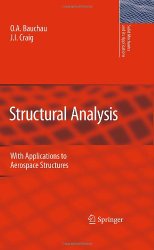Engineering Bookshelf
- Aerospace
- Biological
- Civil
- Chemical
- Environmental
- Electrical
- Materials
- Mechanical
- Petroleum
- Geoengineering
- Software

Structural Analysis: With Applications to Aerospace Structures
by O. A. Bauchau, James I CraigPublisher: Springer
ISBN: 9048125154
Check price @ amazon.com , amazon.ca , amazon.co.uk
Book Description
The authors and their colleagues developed this text over many years, teaching undergraduate and graduate courses in structural analysis courses at the Daniel Guggenheim School of Aerospace Engineering of the Georgia Institute of Technology.
The emphasis is on clarity and unity in the presentation of basic structural analysis concepts and methods. The equations of linear elasticity and basic constitutive behaviour of isotropic and composite materials are reviewed. The text focuses on the analysis of practical structural components including bars, beams and plates. Particular attention is devoted to the analysis of thin-walled beams under bending shearing and torsion. Advanced topics such as warping, non-uniform torsion, shear deformations, thermal effect and plastic deformations are addressed. A unified treatment of work and energy principles is provided that naturally leads to an examination of approximate analysis methods including an introduction to matrix and finite element methods.
This teaching tool based on practical situations and thorough methodology should prove valuable to both lecturers and students of structural analysis in engineering worldwide.
This is a textbook for teaching structural analysis of aerospace structures. It can be used for 3rd and 4th year students in aerospace engineering, as well as for 1st and 2nd year graduate students in aerospace and mechanical engineering.
Book Reviews
“This textbook is based on courses given by both authors at Georgia, Tech and is aimed directly at the early years undergraduates. It succeeds admirably in meeting the students’ needs by including a plethora of set problems and worked examples. … Moreover the way is then open in later years to general weighted residual formulations and applications to nonlinear and non-self-adjoint problems which are powerful tools in modern numerical codes.” (G. A. O. Davies, Aeronautical Journal, March, 2011)